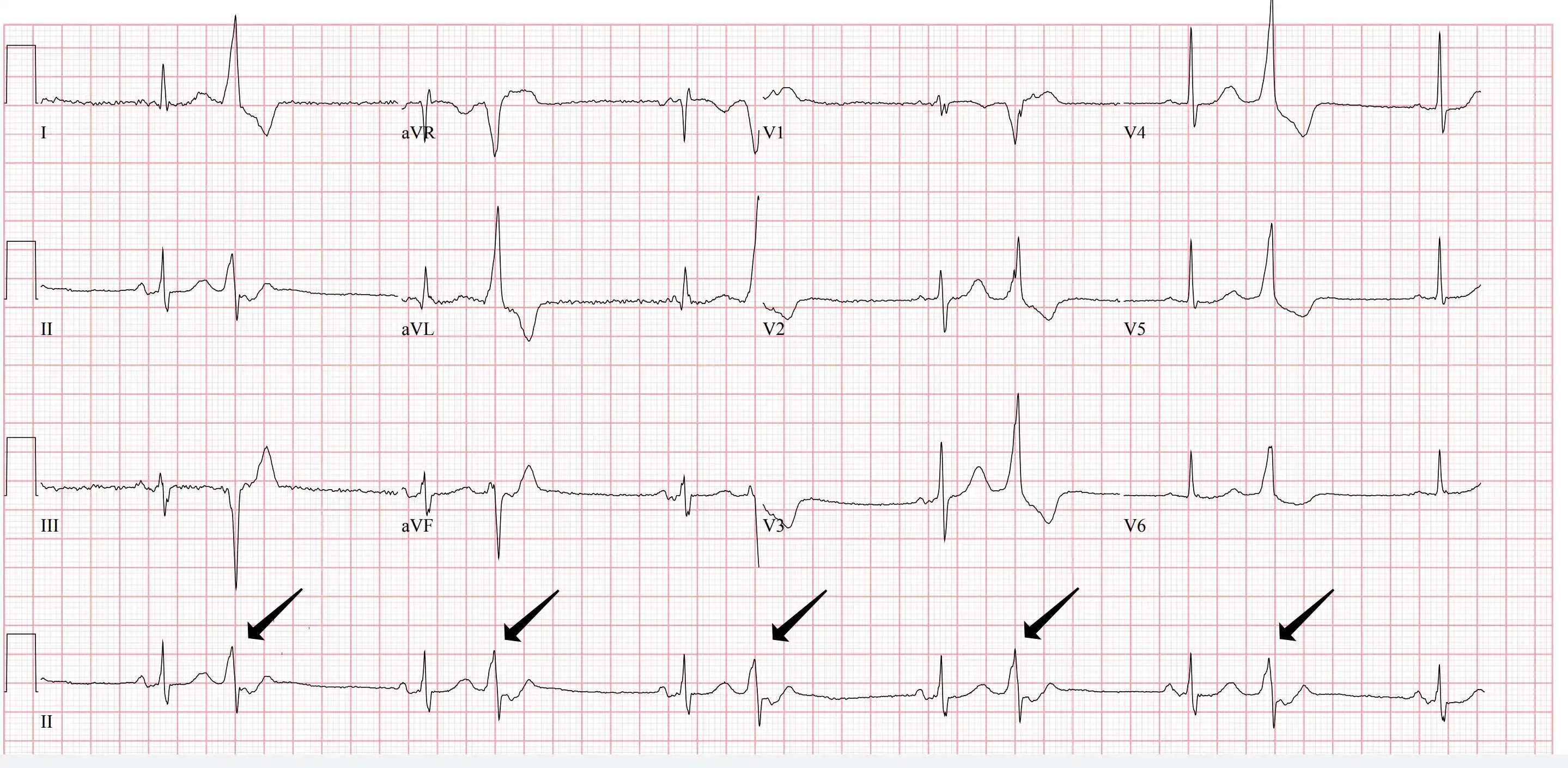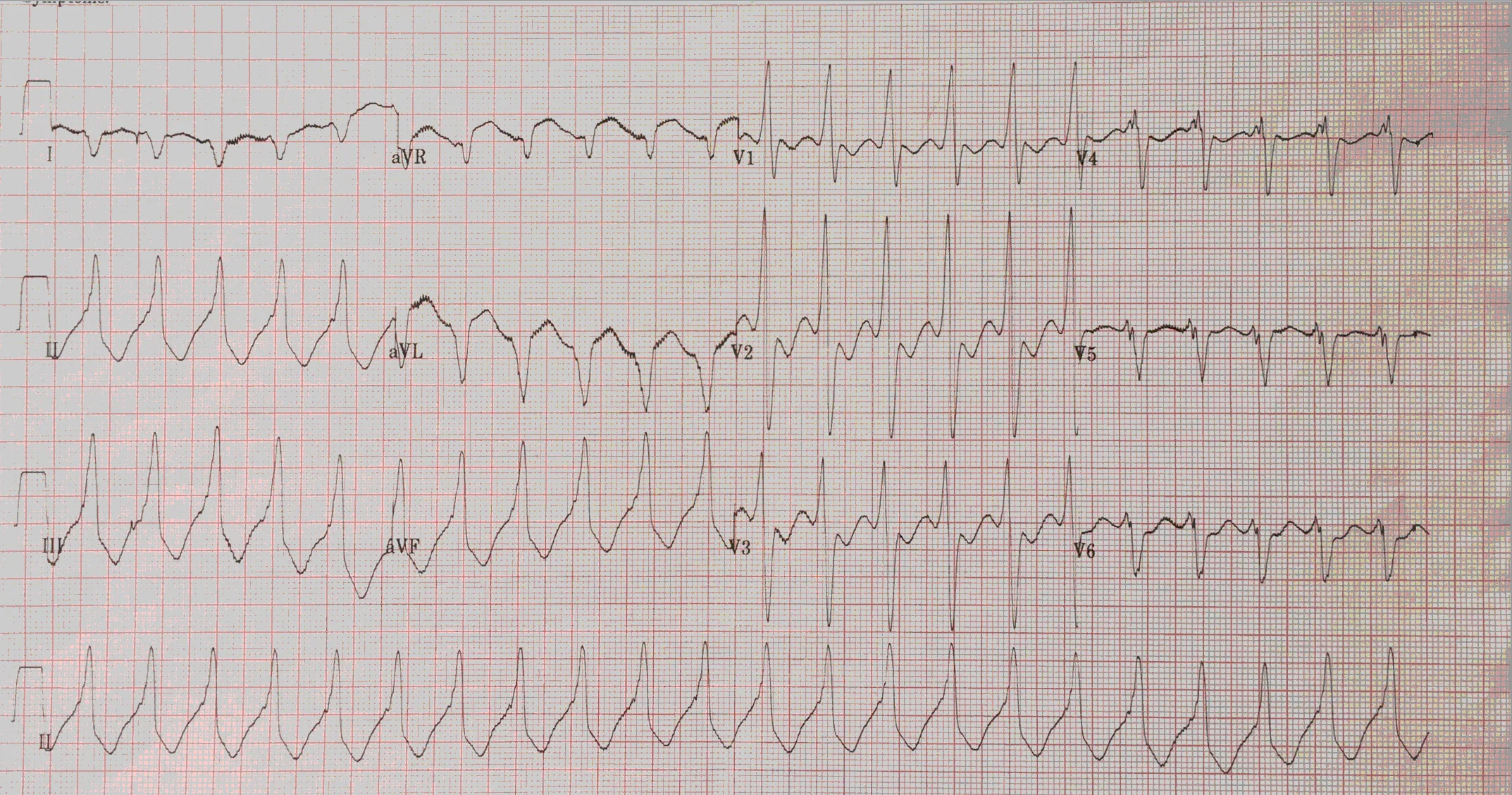Ventricular Tachycardia and Premature Ventricular Contraction Ablation
Premature Ventricular Contraction (PVC) Ablation and Ventricular Tachycardia (VT) Ablation
What are PVCs and VT?
PVC stands for Premature Ventricular Contractions, which are extra (also called ’ectopic) heartbeats originating in the right or left ventricle.

PVCs (arrow) Every Second Beat
VT stands for Ventricular Tachycardia, which is a fast heart beat that may occur focally in one ventricle, or involve both ventricles.

Ventricular Tachycardia (VT)
Why Would It Need Treating?
PVCs are generally benign when they occur in the setting of a structurally normal heart. Either no treatment, or medication, is reasonable. But there are two main reasons why you might consider catheter ablation:
- if the heart function is reduced (tested by an Echocardiogram), elimination of the PVC may improve the function of the heart or even normalise it; in general, PVCs must be very frequent before they affect the function of the heart
- if your symptoms are severe (constant uncomfortable sensations, dizziness, or shortness of breath), and other measures do not work, you may consider catheter ablation as a procedure to improve your quality of life
VT is a more concerning arrhythmia. Elimination of the VT through catheter ablation may reduce your risk of a serious event such as syncope (fainting) or rarely, cardiac arrest. If you have a defibrillator in place then elimination of the VT may reduce the likelihood of receiving a shock from your device.
What is Catheter Ablation for PVC or VT?
Ablation is a medical procedure, performed in hospital, used to treat abnormal heart rhythms, including PVCs and VT.
During catheter ablation, thin flexible wires (called ‘catheters’) are inserted into the femoral vein or artery in the leg, and advanced carefully to the heart.
The catheters are used to track down the origin of the PVC or VT. When in place, the catheter delivers radiofrequency energy to the heart tissue. This heats up and ‘scars’ the tissue underneath the catheter thus eliminating the abnormal tissue which is triggering or maintaining the PVC or VT.
Procedure Details
- Preparation: Before the procedure, you will be asked to fast. On the day, you’ll be placed on a bed and connected to monitors that monitor your heart’s activity.
- Anesthesia: You will receive medication to help you relax or even be put to sleep, so you remain comfortable during the procedure.
- Insertion of Catheters: The doctor will insert the catheters into into the femoral vein or artery in the groin, and guide them to your heart using imaging technology.
- Identifying Problem Areas: Once the catheters are in place, the doctor will induce the abnormal rhythm to identify its source. They will then use the catheters to deliver energy to the problem areas, disrupting the abnormal signals.
- Checking the Results: The doctor will test to ensure the abnormal rhythm cannot be induced again.
- Completion: Once done, the catheters are removed, and you’ll be observed overnight. For some procedures you may be able to go home the same day.
Risks of the Procedure:
Potential risks of the procedure include:
1-2% risk:
- bleeding or infection at the catheter insertion
- blood clot in the vein
- pericardial effusion (fluid around the heart which needs to be drained with a needle)
1% risk
- damage to the normal electrical conduction system of the heart requiring insertion of a pacemaker
<1% risk
- damage to a heart valve, or blood vessel, requiring emergency surgery
- stroke, heart attack
- death (very rare)
Follow Up
You will generally discharge from hospital the following day, and be seen in clinic about a month later.
If you have symptoms of: severe pain, increasing swelling in the groin, fever, or shortness of breath, you should attend emergency and ask them to call Dr Perrin.
Summary
PVC and VT catheter ablation is a procedure used to treat specific abnormal heart rhythms. While generally considered safe and effective, it’s essential to be aware of the potential risks.